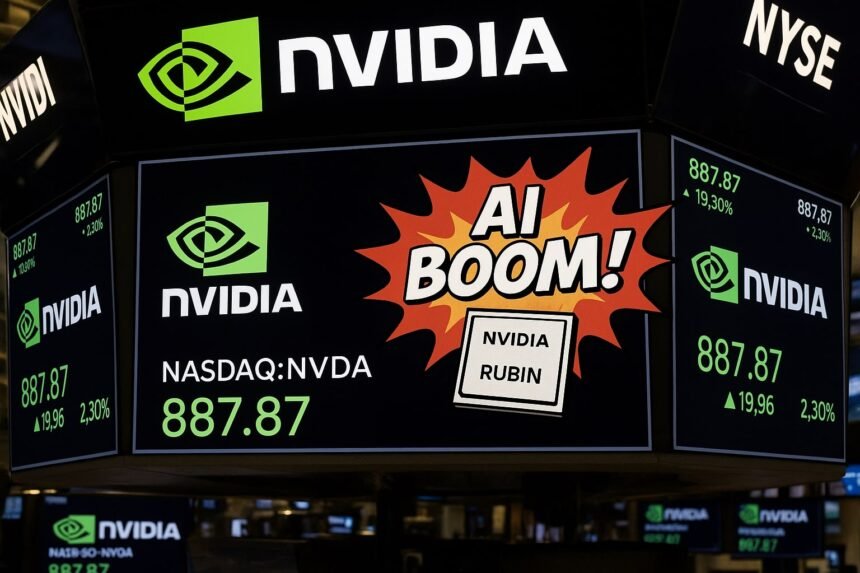NVIDIA Corporation (NASDAQ: NVDA) remains a focal point for investors as it balances explosive AI-driven growth with geopolitical risks and market volatility. With its NVDA stock price today hovering around $131.29 and a market cap of $3.2 trillion, the company’s trajectory hinges on upcoming earnings, competitive dynamics, and its ability to sustain innovation. This 1,300+ word analysis unpacks critical factors shaping NVIDIA’s stock in 2025 and beyond, offering actionable insights for investors.
1. NVDA Stock Price Today: A Snapshot of Volatility
As of May 24, 2025, NVDA stock price stands at $131.29, reflecting a 1.16% dip from the previous close. The stock has traded between $86.62 and $153.13 over the past year, showcasing significant volatility driven by:
-
Geopolitical Tensions: U.S.-China tariff negotiations and export restrictions on AI chips, which cost NVIDIA $15 billion in lost China sales
-
Competitive Pressures: Huawei’s Ascend 910B chips and DeepSeek’s low-cost AI models threaten NVIDIA’s market share
-
Earnings Speculation: Options traders predict a 7.4% swing post-Q1 fiscal 2026 earnings on May 28
For real-time updates on NVDA stock price today, platforms like Yahoo Finance and TradingView remain essential.
2. The 2024 Stock Split: Accessibility vs. Valuation Concerns
NVIDIA executed a 10-for-1 stock split in June 2024, reducing shares from ~$1,200 to $120 to democratize ownership. While splits don’t alter fundamentals, this move boosted retail participation, with 1.2 million new investors entering post-split
Why Another Split Is Unlikely in 2025
-
Current Price Levels: At $131.29, shares remain accessible, negating the need for structural changes
-
Strategic Priorities: NVIDIA is prioritizing Blackwell GPU production and AI partnerships over stock engineering
-
Regulatory Caution: SEC guidelines discourage splits for “hype-driven volatility”
Historically, NVIDIA shares have underperformed post-split by 23% on average, but the 2024 split defied trends with a 25% rally
3. May 28 Earnings: A Pivotal Catalyst
NVIDIA’s Q1 fiscal 2026 earnings report on May 28 will address three critical questions:
a. Can Blackwell GPUs Reignite Growth?
-
Revenue Guidance: NVIDIA projects $43 billion in Q1 revenue (up 65% YoY), driven by Blackwell platform adoption
-
Data Center Demand: Partnerships with AWS, Microsoft, and Oracle aim to convert $1 trillion in traditional data centers into AI hubs
b. China’s Impact on Margins
-
Tariff Headwinds: A $5.5 billion write-off of H20 inventory for China underscores revenue risks
-
Saudi Arabia Deal: A partnership to supply 18,000 GB300 Grace Blackwell processors offers a geopolitical hedge
c. Valuation vs. Execution
Morningstar’s $125 fair value estimate suggests shares are 5% overvalued, but AI demand could justify premium pricing
4. Growth Catalysts: Beyond GPUs
NVIDIA’s long-term value hinges on diversifying its AI ecosystem:
a. AI Factories and Omniverse
CEO Jensen Huang’s vision of “AI factories” — data centers optimized for generative AI — is materializing, with collaborations like the $500 billion Stargate Project 412. The Omniverse platform, used by BMW and Lockheed Martin, could generate $8 billion annually by 2030
b. Automotive and Edge Computing
-
DRIVE Thor Platform: Powers next-gen EVs from Toyota and Hyundai, targeting a $200 billion autonomous vehicle market
-
Edge AI Solutions: RTX 500 GPUs for healthcare and smart cities could unlock $50 billion in annual revenue
c. Software Monetization
The CUDA platform (used by 95% of AI developers) and NVIDIA AI Enterprise 5.0 create sticky revenue streams, with software accounting for 18% of total revenue ($24 billion in fiscal 2025)
5. Risks: Valuation, Competition, and Geopolitics
a. Overvaluation Concerns
-
Forward P/E: 30.49x (vs. 5-year average of 59.3x) suggests vulnerability to earnings misses
-
Margin Pressures: Gross margins dipped to 73.5% in Q4 2025 due to tariff costs
b. Rising Competition
-
AMD’s MI325X: Rivals NVIDIA’s H200 in AI workloads
-
Huawei’s Ascend 910B: Dominates China’s market, eroding NVIDIA’s foothold
c. Geopolitical Flashpoints
-
China Exposure: 25% of revenue is tied to China, where export curbs threaten growth
-
Tariff Volatility: Duties fluctuated between 30% and 145% in 2025, impacting supply chains
6. Analyst Predictions: Bull vs. Bear
| Scenario | 2025 Price Target | 2030 Outlook | Key Assumptions |
|---|---|---|---|
| Bull Case (ARK) | $521.94 | $854+ | 45% annual revenue growth, AI dominance |
| Bear Case | $96.95 | $150 | Market saturation, valuation collapse |
For nuanced analysis, Taza News provides real-time updates on NVDA stock price trends and geopolitical impacts.
7. Investor Strategies: Balancing Risk and Reward
a. Short-Term Traders
-
Earnings Play: Straddle options to capitalize on the expected 7.4% post-May 28 swing
-
Technical Levels: Support at $114.44 (50-day SMA), resistance at $153.13 (ATH)
b. Long-Term Investors
-
Dollar-Cost Averaging: Accumulate shares below $130 to leverage AI’s secular growth
-
Sector Diversification: Pair NVIDIA with stable dividend stocks (e.g., Procter & Gamble)
c. Risk-Adjusted Entry Points
-
Entry Below $120: Aligns with Morningstar’s fair value estimate
-
Exit Above $150: Profit-taking zone ahead of potential corrections
Conclusion: NVIDIA’s Crossroads Between Innovation and Market Realities
NVIDIA’s May 28 earnings report will test its ability to justify a $3.2 trillion valuation amid AI euphoria and geopolitical risks. While the NVDA stock split democratized ownership, long-term success hinges on executing its AI factory vision and fending off competitors. Investors should:
-
Monitor China Demand: Blackwell orders from Alibaba and Tencent could surprise
-
Track Margin Resilience: Tariff impacts and pricing power will shape profitability
-
Diversify Portfolios: Hedge against NVDA’s 10.16% volatility with stable assets
For ongoing insights into NVDA stock price today and split analysis, leverage resources like Taza News, your trusted source for market intelligence.
Disclaimer: This article is for informational purposes only. Consult a financial advisor before making investment decisions.









